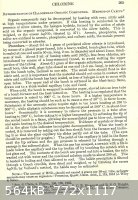Marsh
Hazard to Self
 
Posts: 79
Registered: 28-7-2006
Member Is Offline
Mood: No Mood
|
|
Polymer testing
I currently have two plastic cards, and I would like to test a second card against the first for composition. One card is known to be 60/40
PVC/polyester, and the other card is an unknown ratio, suspected to be 80/20 PVC/polyester.
I'm not sure if there is an ideal way to accomplish this or not. My idea was to use an acid or solvent that reacts with the polyester in the mixture,
that does not act upon the PVC, so that I could perform a dissolving test on the material.
Can any suggestions be given which may result in a successful testing?
Thank you
|
|
|
merrlin
Hazard to Others
  
Posts: 110
Registered: 3-4-2009
Member Is Offline
Mood: No Mood
|
|
Dissolving copolymers with solvents can be tricky. You might consider a mechanical test such as hardness or heat deflection, before attacking the
sample with a solvent.
|
|
|
Ozone
International Hazard
    
Posts: 1269
Registered: 28-7-2005
Location: Good Olde USA
Member Is Offline
Mood: Integrated
|
|
Heat and stretch a sample to give a very thin film (if it's cross-linked your probably screwed). Compare the films using transmission FTIR.
O3
-Anyone who never made a mistake never tried anything new.
--Albert Einstein
|
|
|
UnintentionalChaos
International Hazard
    
Posts: 1454
Registered: 9-12-2006
Location: Mars
Member Is Offline
Mood: Nucleophilic
|
|
I'm somewhat ignorant of what equipment/procedure you'd use, but can you look for relative ratios of chlorine atoms in the two samples?
Department of Redundancy Department - Now with paperwork!
'In organic synthesis, we call decomposition products "crap", however this is not a IUPAC approved nomenclature.' -Nicodem
|
|
|
Panache
International Hazard
    
Posts: 1290
Registered: 18-10-2007
Member Is Offline
Mood: Instead of being my deliverance, she had a resemblance to a Kat named Frankenstein
|
|
If you can't make a decent film, cryogrind the copolymer and make a solid KBr plate for FTIR, DSC (differential scanning calorimetry) would uncover
the composition perfectly, but i don't suppose you have one of those at hand, hence the question.
I would think that analysing your sample quantitatively for chlorine, as suggested by UC, would be the simplest method and as such you could use the
Method of Carius, the reference for this is-
Ann. d. Chem. u. Pharm., 136, 129, 1865.
i don't have it otherwise i would link it. I have attached the summary of the procedure from Scott's (sorry about the size).
I think in 1865 they were sans FTIR and DSC. The method is tedious if you do not have a rudimentary lab setup (you need weighing apparatus accurate to
-/+0.01g or better, chlorine free fuming nitric and a glass bomb or means to make one)).

|
|
|